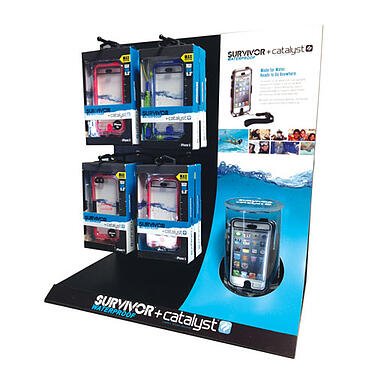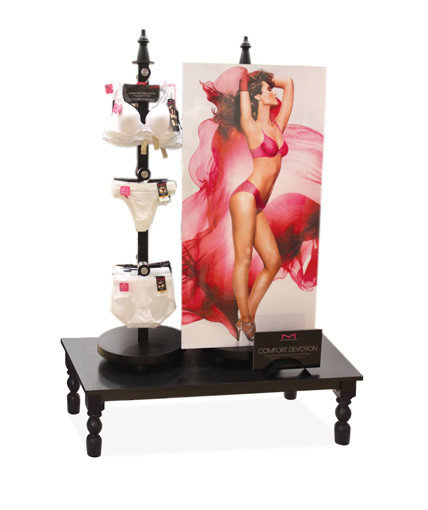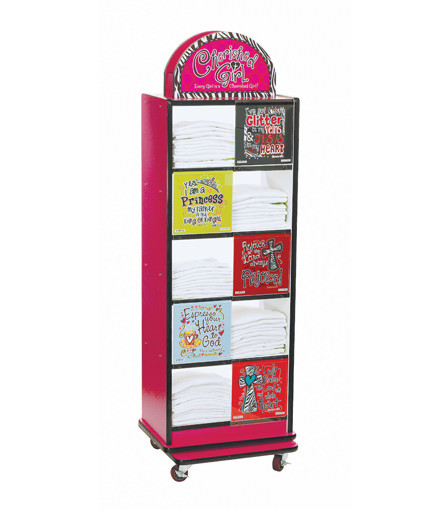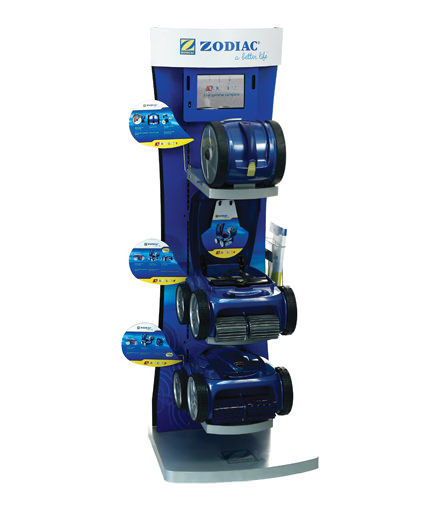In our last blog we wrote about 4 important aspects of designing an effective point-of-purchase display. In this blog, we’ll consider 3 more key aspects of effective design.
- Demonstrate Your Product
Seeing is believing so whenever possible incorporate a product demonstration into your display so as to create real-time in-person testimonials. Point of purchase displays that incorporate well-executed product demonstrations accomplish 4 things:
- They generally enable the shopper to view a product out of its package.
- They engage the shopper at a deeper level.
- They provide the customer with convincing evidence that the product works as claimed.
- They set the display apart from other displays that do not incorporate product demonstrations.
An example is a merchandising pop display we designed for Griffin Technology’s line of fully waterproof Survivor® iPhone cases. The display featured a waterproof case completely submerged in a clear acrylic container of water. Our display effectively created a real-time, in-person testimonial to validate the claim that the Survivor® phone cases are waterproof. The graphic panel on this display provides the customer with additional product information, but it’s the product demonstration that turns the shopper into a customer.

- Make Your Display Interactive
As a general rule, the most effective retail store displays are ones that increase shopper engagement by enabling the shopper to interact with the product. In virtually every case in which the shopper can touch, feel, and interact with the actual product, sales increase.
For example, we had an opportunity to work with PetSafe on an inline fixture designed to showcase its shock collars and dog training products in PetSmart stores. Traditionally, PetSafe merchandised its products in a locking glass case which was designed to enable shoppers to view their products but not steal them. However, higher-end dog training products often require an educational sale, and the locking cases created a barrier between the customer and the product.
Our solution was to reduce the size of the locking case but continue to utilize it to secure high-value products. We reallocated a portion of the space and created a countertop area which featured tethered products that the customer could interact with while learning about the features and benefits of the product through product information cards and back panel graphics. The addition of interactivity to the display resulted in a measurable increase in product sales.
- Use Graphics to Capture Attention
Graphics play a vital role in capturing shopper attention, showing your product and educating potential customers. In almost every retail store environment, shoppers are bombarded with visual stimuli. Not only are product marketers competing with other in-store products, but many shoppers these days are distracted, hurried, and preoccupied with their smart phones, making it increasingly difficult to capture their attention. In most cases, a pop display has only a matter of seconds to attract a shopper.
Bold, eye-catching graphics can make all the difference in capturing the interest of a shopper as well as building a desired brand image. We could offer countless examples of effective graphics used in conjunction with retail display fixtures to capture shopper attention, but we will focus on just two. The first is a graphic-intensive display that we designed for Maidenform. The display was actually simple but quite empowering visually. It consisted of a low rise table, a 3-tiered product glorifier, a small “Comfort Devotion” sign, and a large attention-grabbing graphic.

The second example is an inline display we created for Surf City Garage which helped to set its products apart from the sea of other car care products in the automotive section at Wal-Mart. There were a number of elements that contributed to the success of the display, but the component that was most effective was the large 3D vacuum formed plastic header sign. Relative to competitor signs in the aisle, the Surf City Garage sign helped to set the company’s products apart by creating a premium auto detailing center while also reinforcing the company’s enthusiast-grade brand image.
Graphics can also be used to show your product. Before making a purchase, customers want to see the product they are buying. Sometimes this is difficult to do because of packaging or space constraints. A good example of how graphics can be used effectively to show your product is the 2-sided t-shirt cubbie display we designed for Kerusso’s Cherished Girl t-shirt line. In addition to the brand-building header graphics, each t-shirt style has a graphic showing the design on the front of the t-shirt. This enables the t-shirts to be folded within the cubbies, which is very space-efficient, but it also provides a way for the customer to see the product and choose the design she likes best. RICH LTD. offers a 4-sided version of the t-shirt cubbie display as a stock item.

Finally, graphics can be used to educate the customer on the features and benefits of your product. The trick here is to focus on a few key educational points without making the graphics too text-heavy. Providing customers with a way to learn more through a website or take-away brochure is often a good idea. We designed a retail floor display for Zodiac Pool Systems that not only had header and footer graphics to promote the brand, but it also had a digital media player, product-specific call-out graphics, and a side brochure holder, all of which were focused on educating the customer.
Jim Hollen is the owner and President of RICH LTD. (www.richltd.com), a 35+ year-old California-based point-of-purchase display, retail store fixture, and merchandising solutions firm which has been named among the Top 50 U.S. POP display companies for 9 consecutive years. A former management consultant with McKinsey & Co. and graduate of Stanford Business School, Jim Hollen has served more than 3000 brands and retailers over more than 20 years and has authored nearly 500 blogs and e-Books on a wide range of topics related to POP displays, store fixtures, and retail merchandising.
Jim has been to China more than 50 times and has worked directly with more than 30 factories in Asia across a broad range of material categories, including metal, wood, acrylic, injection molded and vacuum formed plastic, corrugated, glass, LED lighting, digital media player, and more. Jim Hollen also oversees RICH LTD.’s domestic manufacturing operation and has experience manufacturing, sourcing, and importing from numerous Asian countries as well as Vietnam and Mexico.
His experience working with brands and retailers spans more than 25 industries such as food and beverage, apparel, consumer electronics, cosmetics/beauty, sporting goods, automotive, pet, gifts and souvenirs, toys, wine and spirits, home improvement, jewelry, eyewear, footwear, consumer products, mass market retail, specialty retail, convenience stores, and numerous other product/retailer categories.



